Myrmicaria natalensis (F. Smith)
  Type location South
Africa (Physatta natalensis, F. Smith, 1858b: 171, queen;
finally revived as species by Emery, 1922e: 123; Santschi, 1925c: 143,
queen & male) Port Natal Type location South
Africa (Physatta natalensis, F. Smith, 1858b: 171, queen;
finally revived as species by Emery, 1922e: 123; Santschi, 1925c: 143,
queen & male) Port Natal
junior synonyms (here)
eumenoides (Heptacondylus eumenoides n. sp.,
Gerstäcker, 1859: 263, queen; 1862: 514; Myrmicaria eumenoides Gerst., Mayr,
1866b:
906, worker from "Cafferland", or Eastern Cape); synonymy Emery, 1922e:
123, as Myrmicaria natalensis
Smith v. eumenoides
Gerstaecker in
Santschi, 1925c: 145 BUT that was the Arnold worker and not the
Gerstaecker queen) from Mozambique, Tete, collector Peters -
see
below
navicula (Myrmicaria
natalensis Sm. v. navicula n.
var., Santschi, 1925c: 138,
146,
worker) from Tanzania, Pangami, Reichsperger - see below
nigriventris (Myrmicaria
natalensis Sm. v. nigriventris
n. var., Santschi,
1930b: 61, worker) from Angola, Cakindo - see below
obscuriceps (Santschi, 1937d: 226, worker) from South
Africa - see below
verticalis (Myrmicaria
striata Stitz v. verticalis n.
var., Santschi, 1920i: 3,
worker; as M. natalensis
stirps verticalis in
Santschi, 1925c: 138) from Zimbabwe, Bulawayo, G Arnold - see
below
sulcatus (Heptacondylus sulcatus n. sp.,
Mayr, 1862: 756, worker; original location given as "Cuba" but
corrected by Mayr,
1893: 195) from South Africa, Port Natal - no images on Antweb
(September 2016).
all forms described (see Bolton,
1995)  . .
Removed to new status as species: Myrmicaria taeniata (Santschi,
1930d: 269, worker) from Zaïre. The distinguishing features
that readily separate it from the accepted M. natalensis workers are: the
greater number of fine longitudinal striations on the face; the
relatively pale scapes with almost no longitudinal striae; the
longitudinal striae on the promesonotum reaching right to the anterior;
the fine but clear spiculate sculpture on the base of the gaster
(contrary to Santschi's statement).
|
 F
Smith's (1858b) description is at F
Smith's (1858b) description is at  . Gerstäcker's (1859) brief description of
the eumenoides queen is at . Gerstäcker's (1859) brief description of
the eumenoides queen is at  . Mayr's (1862) description of sulcatus
is at . Mayr's (1862) description of sulcatus
is at  . Mayr's (1866b: 906)
description of the eumenoides worker is at . Mayr's (1866b: 906)
description of the eumenoides worker is at  . Arnold (1916: 263 ff) translation and
notes on eumenoides (all forms) is at . Arnold (1916: 263 ff) translation and
notes on eumenoides (all forms) is at  and and  . Santschi's (1930b) description of nigriventris
is at . Santschi's (1930b) description of nigriventris
is at  . Santschi's (1937d)
description of obscuriceps
is at . Santschi's (1937d)
description of obscuriceps
is at  . .
Santschi (footnote on 1920i: 2) noted verticalis as differing from the
type (striata) by the petiole
node having similar faces to the anterior and posterior and closer to
the shape of eumenoides.
|
 The photomontage of
a (presumably F Smith) "syntype" queen is collated from http://www.antweb.org/specimen.do?name=casent0900501.
F Smith (1858b) gave the colour as head, alitrunk and nodes bright
ferruginous; antennae, legs and gaster very dark fusco-ferruginous. The photomontage of
a (presumably F Smith) "syntype" queen is collated from http://www.antweb.org/specimen.do?name=casent0900501.
F Smith (1858b) gave the colour as head, alitrunk and nodes bright
ferruginous; antennae, legs and gaster very dark fusco-ferruginous.
|
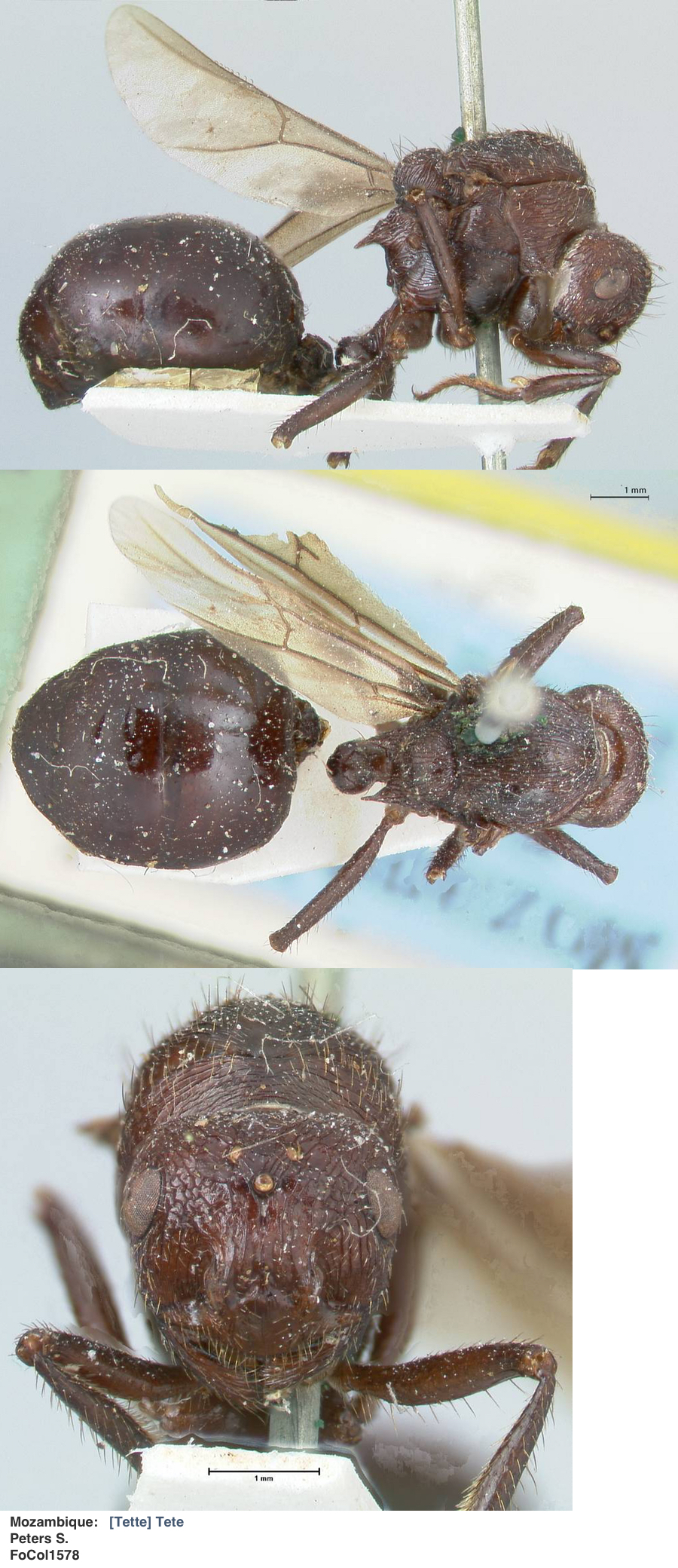 The photomontage of
the (presumably) type queen of eumenoides is collated from http://www.antweb.org/specimen.do?name=focol1578.
Although similar to the Smith syntype queen, this is some 120% larger
(alitrunk length and HW, assuming scales accurate); has EI (EL/HL)
0.32, natalensis EI 0.26;
possibly lighter coloured wings; appears to
lack erect hairs on the gaster; and, has reticulate sculpture on the
frons lateral to the eyes (simply striate on natalensis). The damaged nature of
both queens makes it difficult to be sure. It is listed on Antweb as
"type of Physatta natalensis",
the Gerstaecker (1859) paper was on insects collected by Peters. This,
therefore, is the queen of Heptacondylus
eumenoides. The photomontage of
the (presumably) type queen of eumenoides is collated from http://www.antweb.org/specimen.do?name=focol1578.
Although similar to the Smith syntype queen, this is some 120% larger
(alitrunk length and HW, assuming scales accurate); has EI (EL/HL)
0.32, natalensis EI 0.26;
possibly lighter coloured wings; appears to
lack erect hairs on the gaster; and, has reticulate sculpture on the
frons lateral to the eyes (simply striate on natalensis). The damaged nature of
both queens makes it difficult to be sure. It is listed on Antweb as
"type of Physatta natalensis",
the Gerstaecker (1859) paper was on insects collected by Peters. This,
therefore, is the queen of Heptacondylus
eumenoides.
|
As Emery's (1922e) catalogue entry shows (below), there
was no published work to associate natalensis and eumenoides.
Mayr (1866b: 906) listed Physatta natalensis Sm. in brackets
under the M. eumenoides title but gave no evidence to suggest
why he associated the workers he described with the queens of
Gerstaecker and F Smith. Emery (1893e: 219ff) had notes on the Indian
species Myrmicaria fodica (as M. fodiens) which had eumenoides
as a race; this is at  . In his notes, Emery
specifically states the "Heptacondylus sulcatus" described by
Mayr (1862) and Mayr's (1866b) worker of M. eumenoides (from
Cafferland not Mozambique) did not
differ from those of Gerstaecker. Emery, however, as with Mayr (1862)
either ignored the facts or knew of otherwise unreported specimens of
workers associated with Gerstaecker's queen. . In his notes, Emery
specifically states the "Heptacondylus sulcatus" described by
Mayr (1862) and Mayr's (1866b) worker of M. eumenoides (from
Cafferland not Mozambique) did not
differ from those of Gerstaecker. Emery, however, as with Mayr (1862)
either ignored the facts or knew of otherwise unreported specimens of
workers associated with Gerstaecker's queen.
|

|
Emery (1893e) described examining numerous examples from
Basutoland (Lesotho) and Natal, collected by the missionary J.
Weitzecker and refers to the inconstant characters of eumenoides
in having a clypeus without a median carina but with rugae. He gave eumenoides
as paler than fodica but with the gaster and legs black or dark
brown, contrasting with the clear red of the head and alitrunk. The
other authors had not mentioned the fine puncturation giving a matt
appearance to the base of the gaster.
|
|
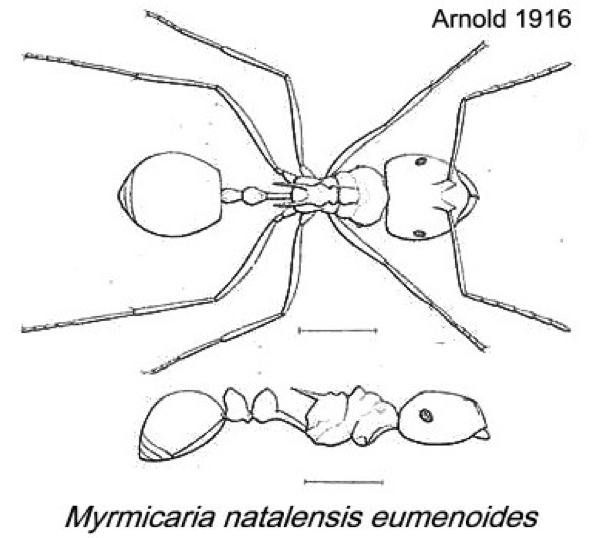 Arnold
(1916: 263) made no reference at all to natalensis but
gave substantial notes on eumenoides. In his key to South
African Myrmicaria, Arnold gave the note - "sculpture strong;
head reticulate (with transverse as well as longitudinal striae; 1st
node as high as the 2nd, pointed above conical"; Arnold
(1916: 263) made no reference at all to natalensis but
gave substantial notes on eumenoides. In his key to South
African Myrmicaria, Arnold gave the note - "sculpture strong;
head reticulate (with transverse as well as longitudinal striae; 1st
node as high as the 2nd, pointed above conical";  . .
|
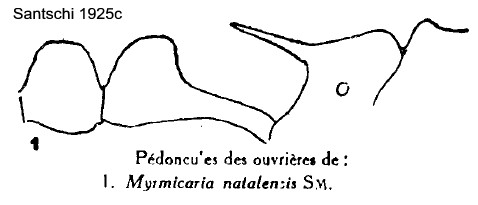 Santschi (1925c) used this species as his benchmark for
separating and describing the species other than exigua (see
below). He gave a full description of natalensis and explained
how he had specimens from a single collection that had sexual and
workers together; this is at Santschi (1925c) used this species as his benchmark for
separating and describing the species other than exigua (see
below). He gave a full description of natalensis and explained
how he had specimens from a single collection that had sexual and
workers together; this is at  . .
Under the heading Heptacondylus
sulcatus Mayr (1863), Santschi described how he had examined a
specimen of Heptacondylus eumenoides
from the original Gerstaecker material, sent to him (Santschi) by
Stitz from the Museum of Berlin. He felt the queen exactly matched the
Smith description, so verifying the Emery (1922) synonymy. Turning back
to the Mayr (1863) description of H.
sulcatus
workers, Santschi said he possesed a queen from Mozambique, plus one
from Natal. The latter was collected with workers and a queen, so
enabling him to be confident on the worker-queen relation.
My translation of Santschi's description is -
WORKER - TL 5.5-7 mm. Colour a variable reddish
-brown. Gaster chestnut-brown often darker than thorax. Antenna and
tarsi of an intermediate brown. Erect pilosity reddish-brown, fairly
long but inequal and quite abundant on body and appendages. A central
ridge runs the full length of the face to the cervical border. The
central area of the face feebly striated between the frontal carinae,
smooth either side of the median at the level of the eyes. The
transverse ridge of the vertex is unique, sharp and anastomoses (links)
the rugae on the vertex, those continuing to diverge on the occipitum.
These rugae are moderately spaced and the spaces are smooth. The cheeks
have several longitudinal rugae which continue in the area of the scape
(scrobe?) inclining inside with little anastomosis. The sides of the
head are finely striate longitudinally with a variable shiny area
towards the inferior border. Promesonotum with a strong median carina,
more pronounced on the anterior of the pronotum where it is traversed
at right-angles by one to three arched rugae which become near parallel
on the sides of the dorsum. The median carina reaches a posterior
transverse carina which separates the dorsal and posterior faces of the
mesonotum. The bordering ridges of the mesonotum are slightly prolonged
forward on to the pronotum with a similarly sized smooth space between
them and the median carina. The declivity of the mesonotum, the dorsum
and declivity of the propodeum, the abdomen and the base of the gaster,
plus the femora and tibia are smooth. The alitrunk sides have spaced
and feeble longitudinal striae and the scapes and part of the tibiae
are striated.
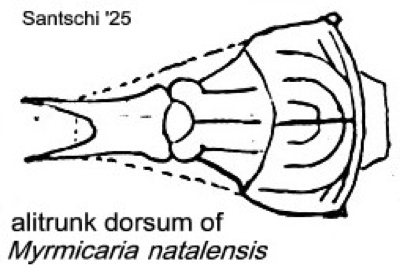 Head
slightly longer than wide, narrowing slightly
anteriorly; sides near straight to the level of the eyes and arched
posteriorly; the posterior margin near straight, with the occipital
border markedly concave. Eyes convex and situated in the third quarter
of the sides. Frontal carinae slightly sinuous with a well defined
lobe. Anterior clypeal border straight with a strong median carina
running more feebly on to the clypeus. Latter is convex, subcarinate
and faintly striate on the sides. Mandibles densely striated, with 4 or
5 teeth. The antennal scape about one-third as long again past the
occiput. Funiculus segments 1 and 3 subequal, segment 2 a quarter
longer than its neighbours and as long as segment 5. Pronotum slightly
convex transversely, moderate bordered in front and laterally by rugae.
The promesonotal suture is well defined but shallow. Mesonotal lobes
raised to appear as sills in profile. Mesonotum declivity is convex and
higher anteriorly. Metanotal groove open before the basal lobes of the
propodeum. The propodeal dorsum is twice as long as wide and one-third
wider anteriorly, transversely concave the borders raised into low
lobes in the anterior third. The length of the propodeal spines is
about two thirds that of the propodeal dorsum and they continue in a
horizontal plane with the dorsum; the spines are a little longer than
their basal separation. The propodeal declivity is rectangular, flat
and bordered. The petiole peduncle is arched, unarmed ventrally, a
quarter long than the node. The node is as high as it is long, the
anterior face steeper than the posterior and the posterior-superior
angle is less acute than the anterior angle. Postpetiole slightly
higher than petiole, profile more conical; ventral appendage limited
and as straight as the petiole summit. Base of gaster truncated. Head
slightly longer than wide, narrowing slightly
anteriorly; sides near straight to the level of the eyes and arched
posteriorly; the posterior margin near straight, with the occipital
border markedly concave. Eyes convex and situated in the third quarter
of the sides. Frontal carinae slightly sinuous with a well defined
lobe. Anterior clypeal border straight with a strong median carina
running more feebly on to the clypeus. Latter is convex, subcarinate
and faintly striate on the sides. Mandibles densely striated, with 4 or
5 teeth. The antennal scape about one-third as long again past the
occiput. Funiculus segments 1 and 3 subequal, segment 2 a quarter
longer than its neighbours and as long as segment 5. Pronotum slightly
convex transversely, moderate bordered in front and laterally by rugae.
The promesonotal suture is well defined but shallow. Mesonotal lobes
raised to appear as sills in profile. Mesonotum declivity is convex and
higher anteriorly. Metanotal groove open before the basal lobes of the
propodeum. The propodeal dorsum is twice as long as wide and one-third
wider anteriorly, transversely concave the borders raised into low
lobes in the anterior third. The length of the propodeal spines is
about two thirds that of the propodeal dorsum and they continue in a
horizontal plane with the dorsum; the spines are a little longer than
their basal separation. The propodeal declivity is rectangular, flat
and bordered. The petiole peduncle is arched, unarmed ventrally, a
quarter long than the node. The node is as high as it is long, the
anterior face steeper than the posterior and the posterior-superior
angle is less acute than the anterior angle. Postpetiole slightly
higher than petiole, profile more conical; ventral appendage limited
and as straight as the petiole summit. Base of gaster truncated.
|
Santschi also gave the following key to the subspecies
of natalensis,
and this seems to summarize the difference
effectively. With the availability of most of the type images and the
fresh specimens shown below, my feeling now (October 2014) is that most
of the variation perceived by Santschi owes itself simply to size
variations in what is a polymorphic species (see the Botswana
specimens).
| 1 |
Colour mainly black; central area of
head largely smooth as is the gaster; propodeum dorsum often less
concave anteriorly; anterior of petiole near vertical; TL 6.3 mm
(Zimbabwe) |
st. verticalis
Santschi |
| -- |
Colour otherwise; propodeum dorsum
concave, sides raised in accentuated ridges (flanges) |
2 |
| 2 |
Mesonotum declivity concave,
separated by a crest from the dorsum; TL 6.5 mm; reddish-brown
(Tanzania) |
var. navicula
Santschi |
| -- |
Mesonotum declivity convex, separated
by a simple rugula from the dorsum |
3 |
| 3 |
Base of gaster largely unsculptured,
shiny; reddish-brown, gaster more brown; TL 5.8-7.2 mm (Natal) |
natalensis
s.s. Smith |
| -- |
Base of gaster largely sculptured,
matt; dull red-brown; gaster black; TL 6.5-7 mm (East Africa and
Zimbabwe) |
var. eumenoides |
 Santschi
(1930d) had taeniata n. var. as - "worker - brown ochre or
light reddish, vertex and gaster darker brown, gastral tergites with a
brown border; frons of head with denser rugae similar to eumenoides;
pedicel nodes and gaster smooth; like irregularis but with eumenoides
pedicel nodes. Zaïre, Katanga, Dr Staffers. Santschi (1939b: 238)
simply noted that he established Myrmicaria natalensis st. obscuriceps
from Southern Rhodesia (Zimbabwe) Bembeisi, 14.ii.1928, 4 workers, for
the form shown by Arnold (1924, Plate VII, as M. striata, i.e.
with the postpetiole much lower than the petiole. Santschi
(1930d) had taeniata n. var. as - "worker - brown ochre or
light reddish, vertex and gaster darker brown, gastral tergites with a
brown border; frons of head with denser rugae similar to eumenoides;
pedicel nodes and gaster smooth; like irregularis but with eumenoides
pedicel nodes. Zaïre, Katanga, Dr Staffers. Santschi (1939b: 238)
simply noted that he established Myrmicaria natalensis st. obscuriceps
from Southern Rhodesia (Zimbabwe) Bembeisi, 14.ii.1928, 4 workers, for
the form shown by Arnold (1924, Plate VII, as M. striata, i.e.
with the postpetiole much lower than the petiole.
It should be noted the TL of sulcatus, from Port Natal, was
given as 8-9 mm by Mayr (1862) and that of eumenoides was given
as 8-9 mm by Lévieux (1983a). Those shown below from South Africa are
in
that larger size range. The measurements given by Lévieux (1983a) may,
however, be of the (now) separate species Myrmicaria taeniata, see my note
and page link above.
|
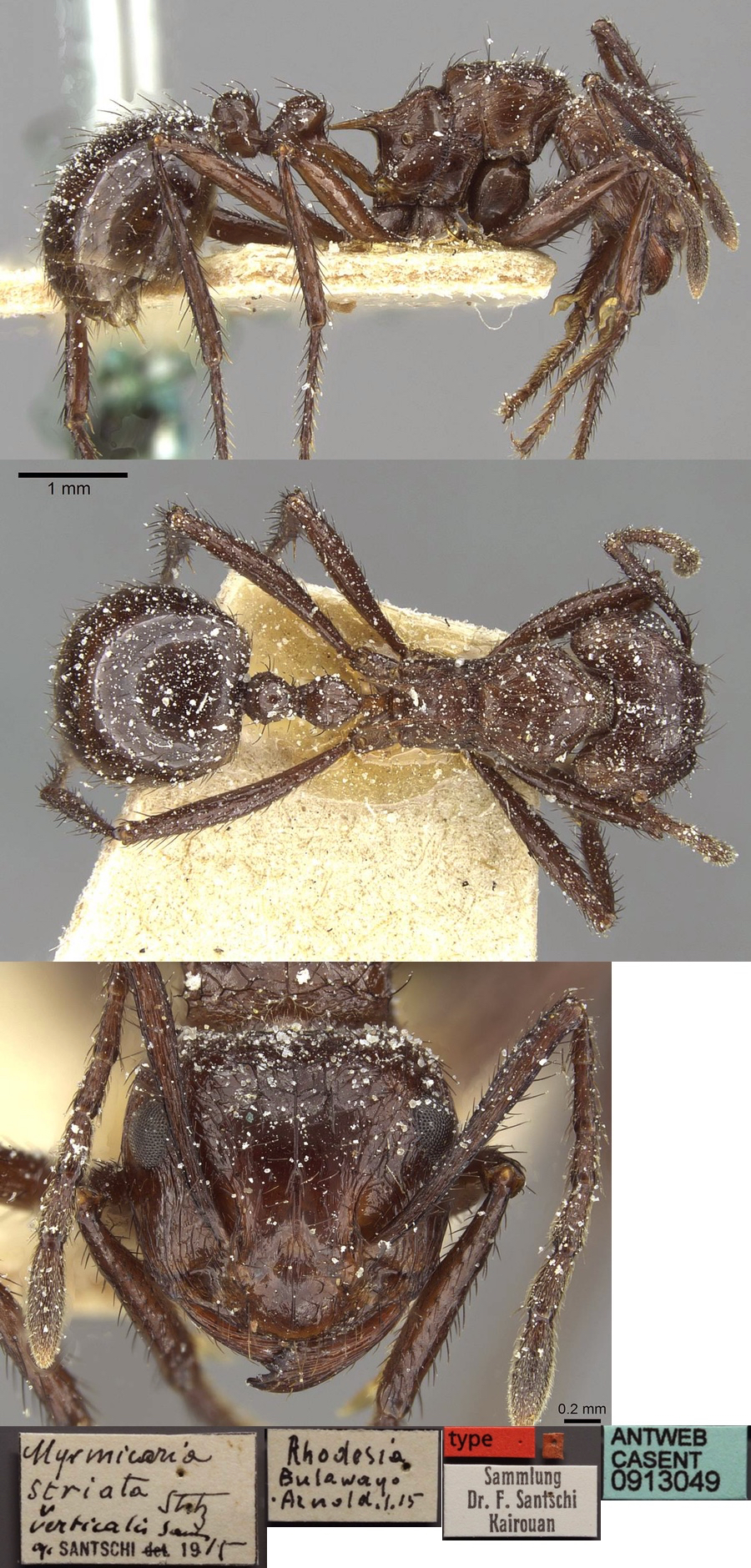 The photomontage of
the verticalis type worker is
collated from http://www.antweb.org/specimen.do?name=casent09130491. The photomontage of
the verticalis type worker is
collated from http://www.antweb.org/specimen.do?name=casent09130491.
|
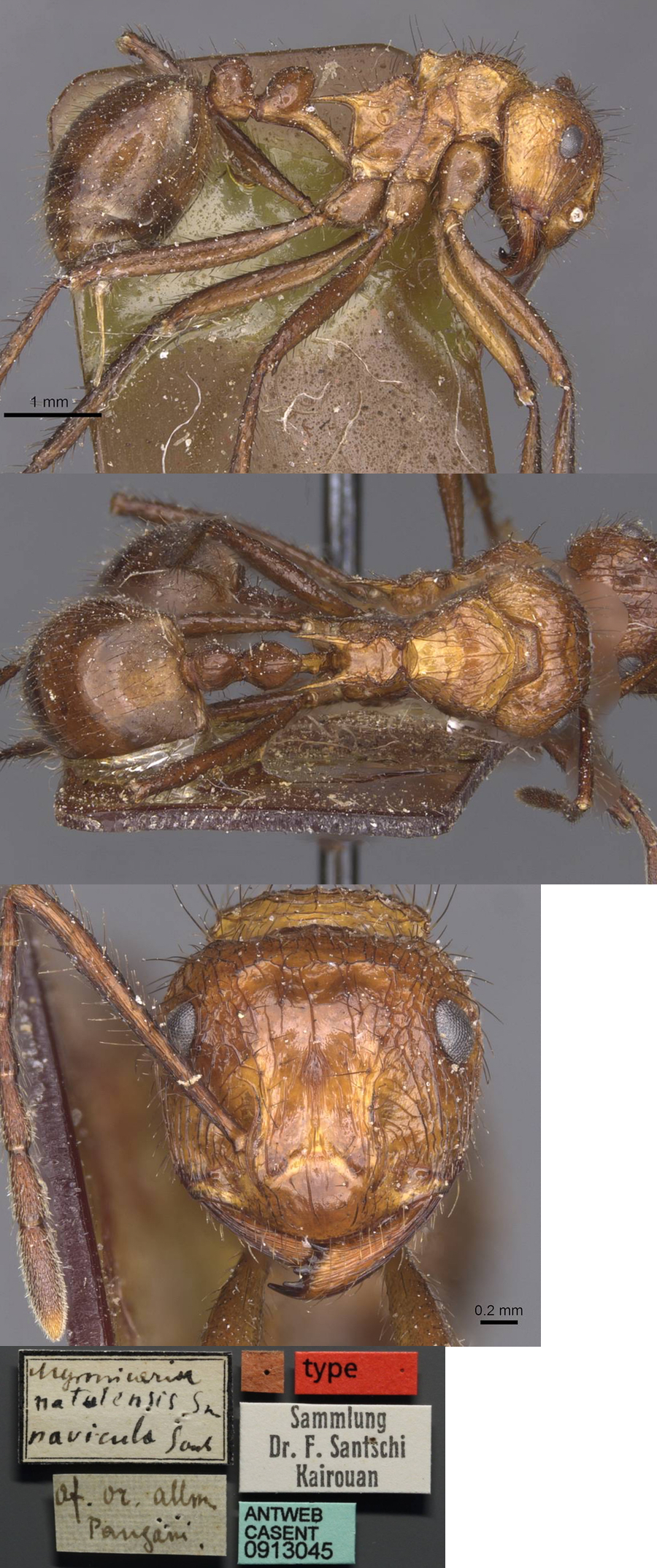 The photomontage of
the navicula type worker is
collated from http://www.antweb.org/specimen.do?name=casent0913045. The photomontage of
the navicula type worker is
collated from http://www.antweb.org/specimen.do?name=casent0913045.
|
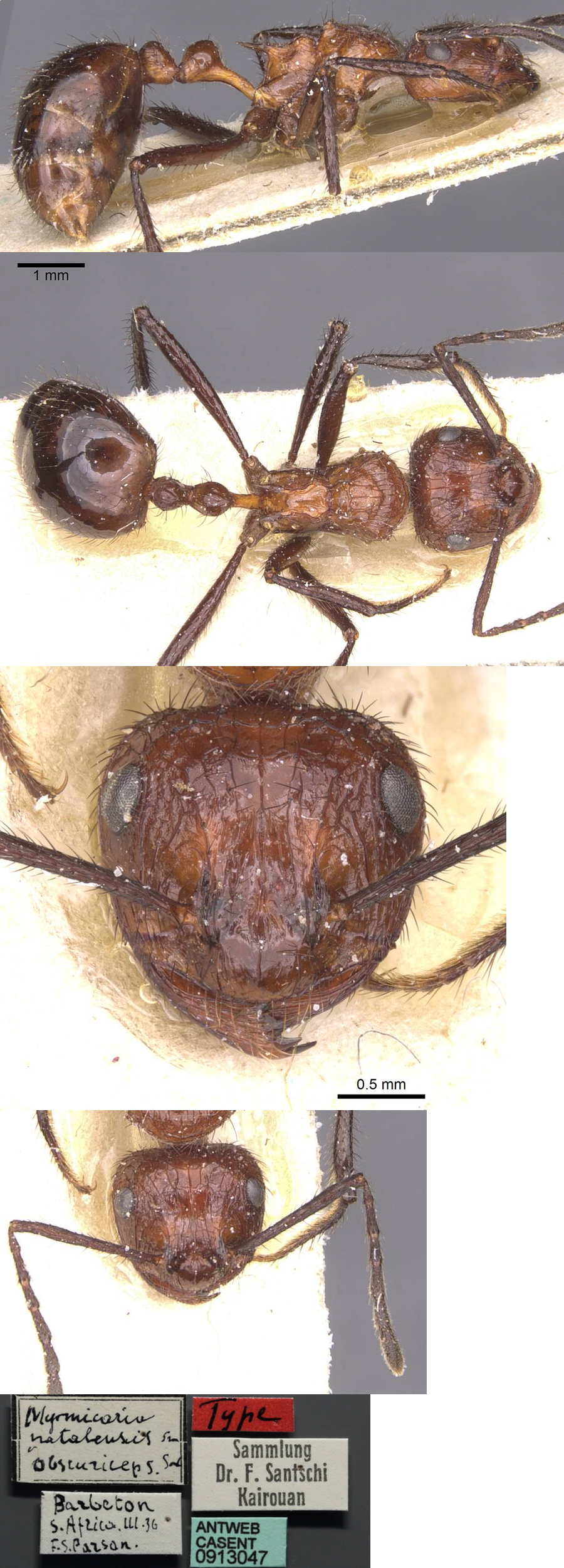 The photomontage of
the obscuriceps type worker
is
collated from http://www.antweb.org/specimen.do?name=casent0913047. The photomontage of
the obscuriceps type worker
is
collated from http://www.antweb.org/specimen.do?name=casent0913047.
|
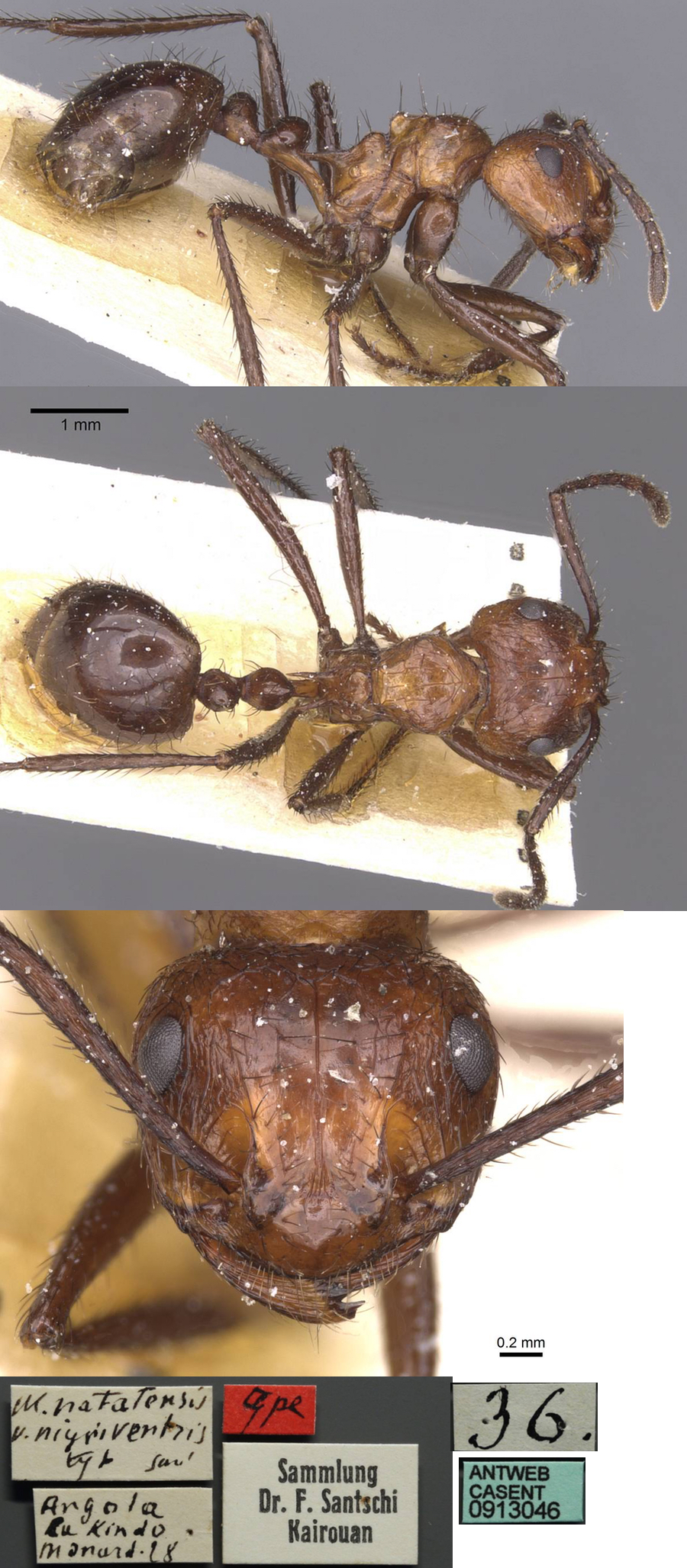 The photomontage of
the nigriventris type worker
is
collated from http://www.antweb.org/specimen.do?name=casent0913047. The photomontage of
the nigriventris type worker
is
collated from http://www.antweb.org/specimen.do?name=casent0913047.
|
Oxford University Museum
specimens
Myrmicaria natalensis
B Taylor det. |
South Africa
Peter Hlavác
|
10-11.ii.2004
Mpumalanga
25°13.1' S
30°37' E
|
Mpumalanga, Sabie
env., 1200 m
|
1
|
 |
Myrmicaria natalensis
B Taylor det. |
Botswana
King 115
|
1.xi.2010
Xakanaxa Camp
19.11.01S
23.24.30E
|
961 m
Forest
Foraging on the ground. Nest in soil
|
4
|
 |
|
 The
photomontage is of a worker from
Mpumalanga, South Africa, Sabie env.; collector Peter Hlavác. The
photomontage is of a worker from
Mpumalanga, South Africa, Sabie env.; collector Peter Hlavác.
Apart from the paler colour
this
matches the Arnold (1916) translation (or modified description). It is
bigger than but
otherwise matches the type form as described by Santschi (1925c), see
above. It also matches the navicula
and obscuriceps images on
Antweb (link above). The contrasting dark scapes seem diagnostic.
|
 The
photomontage show the polymorphism of workers from Botswana, collector David M
King). The various morphs can be seen on Botswana
polymorphism The
photomontage show the polymorphism of workers from Botswana, collector David M
King). The various morphs can be seen on Botswana
polymorphism
The Antweb images of nigriventris and navicula (see link above) match
the size, form and colour of the minima from Botswana. Similarly the obscuriceps images match the
Botswana media 2.
|
 The specimens in these field photographs were taken in St.
Lucia, Kwazulu, Natal, South Africa, by Joan Young; nos 101_2909 to
2911. The specimens in these field photographs were taken in St.
Lucia, Kwazulu, Natal, South Africa, by Joan Young; nos 101_2909 to
2911.
|
|